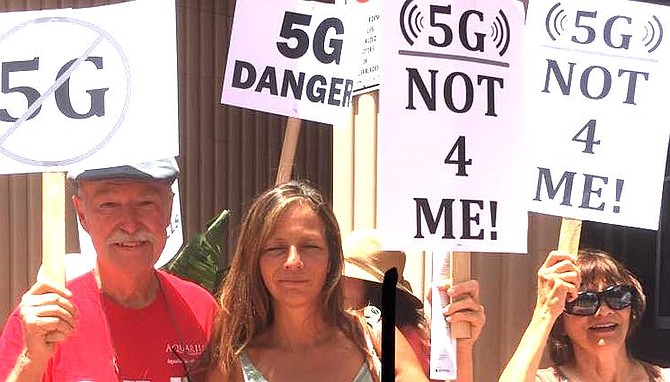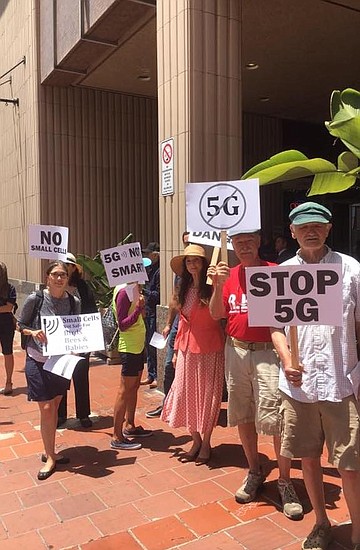 Facebook
Facebook
 X
X
 Instagram
Instagram
 TikTok
TikTok
 Youtube
Youtube

Last Tuesday, July 23, the San Diego City Council heard from critics, loud and clear, before voting to approve 5G guidelines. While the city touts its stealth designs, techno-blight isn't the only thing opponents care about.
Health impacts from inescapable radiofrequency was a top concern. In fact, health concerns carry no weight in the process; a 1996 federal law bars cities from considering the health effects of radio frequency in siting towers.

Tucked into the city's twelfth land-use update are "small cell" guidelines that will fast-track thousands of mini cell towers throughout the city, a requirement of a new federal law that took effect in January. They'll go on street lights and traffic signs, in parks, near schools, by homes.
"We have no poles, no cobra lights, so every 5G installation will be a separate tower," said Don Taylor, chair of the Kensington-Talmadge community planning group, which sought changes to the draft. The group's first wish was to ensure that projects proposed in historic and potential historic districts "shall not erode the aesthetic character of the community."
Done. The federal order allows eyesores if the city has no design criteria. "Fortunately, we do," said city planner Simon Tse. The Kensington group wanted to follow city staff's recommendation that the guidelines go into the land development code manual so they are enforceable. Planning groups rely on the city's current wireless guidelines to evaluate small cell installations.
And third was a change sought by health advocates: a wireless community master plan. "With no master plan from any telecom company, we have no idea what they are each going to do – where small cells will go and exactly how many and on how many poles, existing or new," says Sue Brinchman, director of the nonprofit Center for Electrosmog Prevention, in an email.
That one didn't fly. According to a memo from the city attorney, such a plan would require extensive public comments on sites, sure to slow the process – against the Federal Communications Commission order.
But city planner Karen Lynch said for new poles coming into the right-of-way in Kensington, there would be a Neighborhood Use Permit process that would allow community voices, and the decision could be appealed to the planning commission. Planners would recommend the carrier come in with as many sites as they can for the community to aid the review, "almost like a Master Plan, but not – it's just several locations."
The rollout could begin early as this year, driven by the new law that limits local control and imposes "shot clock" timeframes to process applications: 60 days for equipment on existing structures or 90 days for new ones.
"This is good for the wireless industry but it removes any flexibility the city has to 'partner' with the applicant during project review," notes city staff reports. Since "this partnership often serves as a substitute for due diligence," applicants must do their research.
The guidelines would allow facilities up to 15 cubic feet, attached to an existing light pole or traffic signal, to be processed by ministerial application.
San Diego has come a long way in its design guidelines, Lynch said. "What was allowed 20 years ago is no longer allowed today. Out of the top 10 major cities in the U.S., none have better concealment of macro facilities or better designed small cell sites, likely attributable to our regulations and guidelines."
Health advocates see it differently. Stealth designs won't make up for all the new towers that will sprout like branches on trees – only the trees may have to be removed to make way; trees interfere with certain 5G radiowaves.
"I see an emphasis on concealment with zero safety considerations," Brinchman says of the city's new guidelines. "I see permission to place up to four small cells on one pole." And worst of all, there are "zero setbacks from residences."
Some cities have more protective ordinances that put greater distance between the small cells and people, she says. Marin County's new rules don't allow 5G antenna within 1,500 feet of schools and require antennae to be located a minimum of 1,000 feet apart.
The World Health Organization classified radiofrequency radiation as a possible carcinogen in 2011. While 5G operates on a much higher frequency than earlier generations, it won't replace existing networks, but will expand them to fill in coverage gaps.
Several speakers at the meeting called for the council to delay the vote. "We're just assuming based on research done more than 20 years ago that this is okay," said Antonia Mahoney.
"But we won't know until we put it outside our kids' bedrooms."


Last Tuesday, July 23, the San Diego City Council heard from critics, loud and clear, before voting to approve 5G guidelines. While the city touts its stealth designs, techno-blight isn't the only thing opponents care about.
Health impacts from inescapable radiofrequency was a top concern. In fact, health concerns carry no weight in the process; a 1996 federal law bars cities from considering the health effects of radio frequency in siting towers.

Tucked into the city's twelfth land-use update are "small cell" guidelines that will fast-track thousands of mini cell towers throughout the city, a requirement of a new federal law that took effect in January. They'll go on street lights and traffic signs, in parks, near schools, by homes.
"We have no poles, no cobra lights, so every 5G installation will be a separate tower," said Don Taylor, chair of the Kensington-Talmadge community planning group, which sought changes to the draft. The group's first wish was to ensure that projects proposed in historic and potential historic districts "shall not erode the aesthetic character of the community."
Done. The federal order allows eyesores if the city has no design criteria. "Fortunately, we do," said city planner Simon Tse. The Kensington group wanted to follow city staff's recommendation that the guidelines go into the land development code manual so they are enforceable. Planning groups rely on the city's current wireless guidelines to evaluate small cell installations.
And third was a change sought by health advocates: a wireless community master plan. "With no master plan from any telecom company, we have no idea what they are each going to do – where small cells will go and exactly how many and on how many poles, existing or new," says Sue Brinchman, director of the nonprofit Center for Electrosmog Prevention, in an email.
That one didn't fly. According to a memo from the city attorney, such a plan would require extensive public comments on sites, sure to slow the process – against the Federal Communications Commission order.
But city planner Karen Lynch said for new poles coming into the right-of-way in Kensington, there would be a Neighborhood Use Permit process that would allow community voices, and the decision could be appealed to the planning commission. Planners would recommend the carrier come in with as many sites as they can for the community to aid the review, "almost like a Master Plan, but not – it's just several locations."
The rollout could begin early as this year, driven by the new law that limits local control and imposes "shot clock" timeframes to process applications: 60 days for equipment on existing structures or 90 days for new ones.
"This is good for the wireless industry but it removes any flexibility the city has to 'partner' with the applicant during project review," notes city staff reports. Since "this partnership often serves as a substitute for due diligence," applicants must do their research.
The guidelines would allow facilities up to 15 cubic feet, attached to an existing light pole or traffic signal, to be processed by ministerial application.
San Diego has come a long way in its design guidelines, Lynch said. "What was allowed 20 years ago is no longer allowed today. Out of the top 10 major cities in the U.S., none have better concealment of macro facilities or better designed small cell sites, likely attributable to our regulations and guidelines."
Health advocates see it differently. Stealth designs won't make up for all the new towers that will sprout like branches on trees – only the trees may have to be removed to make way; trees interfere with certain 5G radiowaves.
"I see an emphasis on concealment with zero safety considerations," Brinchman says of the city's new guidelines. "I see permission to place up to four small cells on one pole." And worst of all, there are "zero setbacks from residences."
Some cities have more protective ordinances that put greater distance between the small cells and people, she says. Marin County's new rules don't allow 5G antenna within 1,500 feet of schools and require antennae to be located a minimum of 1,000 feet apart.
The World Health Organization classified radiofrequency radiation as a possible carcinogen in 2011. While 5G operates on a much higher frequency than earlier generations, it won't replace existing networks, but will expand them to fill in coverage gaps.
Several speakers at the meeting called for the council to delay the vote. "We're just assuming based on research done more than 20 years ago that this is okay," said Antonia Mahoney.
"But we won't know until we put it outside our kids' bedrooms."
Comments